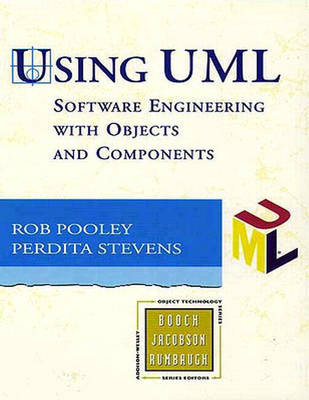
Using UML
Addison Wesley Publishing Company (Verlag)
978-0-201-36067-7 (ISBN)
- Titel ist leider vergriffen;
keine Neuauflage - Artikel merken
Using UML is an introduction to the Unified Modeling Language for students learning about object- and component-based software design and development. It places UML in the context of the software engineering discipline as a whole, providing students with a practical understanding of good practice in software design and development. The authors present a broad view of the subject area, enabling students to see for themselves how different practices may be appropriate for different situations. The goal of the book is to encourage a pragmatic and open-minded approach to real-life software engineering. The book is divided into four parts containing introductory and more advanced chapters. Depending on their existing knowledge and experience, readers can follow different routes through the material (see preface for details). Part 1 introduces the concepts of software engineering and object-oriented development. Part 2 covers UML, the language. Part 3 consists of three case studies. Part 4 discusses issues which are important in putting the techniques taught in the book into practice in a quality- and reuse-conscious environment.
Topics covered include patterns, testing, software project management, teamwork and quality assurance. The authors Dr Rob Pooley is Professor of Computer Science at Heriot-Watt University, Edinburgh. Dr Perdita Stevens lectures in the Computer Science department at the University of Edinburgh. The book is based on two courses they have developed and taught: an introduction to object-orientation and UML, and a more advanced course on software engineering with objects and components.
I Conceptual background 1 Software engineering with components. 1.1 What is a good system? 1.2 Do we have good systems? 1.3 What are good systems like? 1.4 How are good systems built? 2 Object concepts. 2.1 What is an object? .2 How does this relate to the aims of the previous chapter? 2.3 Inheritance. 2.4 Polymorphism and dynamic binding. 3 Introductory case study. 3.1 The problem. 3.2 Scope and iterations. 3.3 Identifying classes. 3.4 Relations between classes. 3.5 The system in action. 4 The development process. 4.1 Defining terms. 4.2 The development process. 4.3 System, design, model, diagram. II The Unified Modeling Language 5 Essentials of class models. 5.1 Identifying objects and classes. 5.2 Associations. 5.3 Attributes and operations. 5.4 Generalisation. 5.5 The class model during the development. 5.6 CRC cards. 6 More on class models. 6.1 More about associations. 6.2 More about classes. 6.3 Parameterised classes 6.4 Dependency. 6.5 Components and packages. 6.6 Visibility, protection. 7 Essentials of use case models. 7.1 Actors in detail. 7.2 Use cases in detail. 7.3 System boundary. 7.4 Using use cases. 7.5 Possible problems with use cases. 8 More on use case models. 8.1 Relationships between use cases. 8.2 Relationships between actors. 8.3 Actors and classes 9 Essentials of interaction diagrams. 9.1 Collaborations. 9.2 Interactions on collaboration diagrams. 9.3 Sequence diagrams. 9.4 More advanced features. 9.5 Interaction diagrams for other purposes. 10 More on interaction diagrams. 10.1 Generic interaction diagrams. 10.2 Concurrency. 11 Essentials of state and activity diagrams. 11.1 State diagrams. 11.2 Activity Diagrams. 12 More on state and activity diagrams. 12.1 Other kinds of events. 12.2 Other kinds of actions. 12.3 Looking inside states. 12.4 Concurrency within states. 13 Implementation diagrams. 13.1 Component model. 13.2 Deployment model. 14 Packages, subsystems, models. 14.1 Package. 14.2 Subsystems. 14.3 Models. III Case studies 15 CS4 administration. 15.1 The case study. 15.2 Discussion 16 Board games. 16.1 Scope and preliminary analysis. 16.2 Interaction. 16.3 Back to the framework. 16.4 States. 17 Discrete event simulation. 17.1 Requirements. 17.2 Outline class model. 17.3 Use Cases. 17.4 Standard mechanism for process based simulation. 17.5 Associations and navigability. 17.6 Classes in detail. 17.7 Class Report. 17.8 Class Statistic. 17.9 Building a complete simulation model. 17.10. The dining philosophers. IV Towards practice 18 Reuse: components, patterns. 18.1 Practicalities of reuse. 18.2 Design Patterns. 18.3 Frameworks. 19 Product quality: verification, validation, testing. 19.1 Quality review. 19.2 How can high quality be achieved? 19.3 Verification. 19.4 Validation. 19.5 Testing. 19.6 Reviews and inspections. 20 Process quality: management, teams, QA. 20.1 Management. 20.2 Teams. 20.3 Leadership. 20.4 Quality assurance. 20.5 Further reading.
| Erscheint lt. Verlag | 3.12.1998 |
|---|---|
| Sprache | englisch |
| Maße | 172 x 234 mm |
| Gewicht | 420 g |
| Themenwelt | Informatik ► Software Entwicklung ► Objektorientierung |
| Informatik ► Software Entwicklung ► UML | |
| ISBN-10 | 0-201-36067-5 / 0201360675 |
| ISBN-13 | 978-0-201-36067-7 / 9780201360677 |
| Zustand | Neuware |
| Haben Sie eine Frage zum Produkt? |
aus dem Bereich


